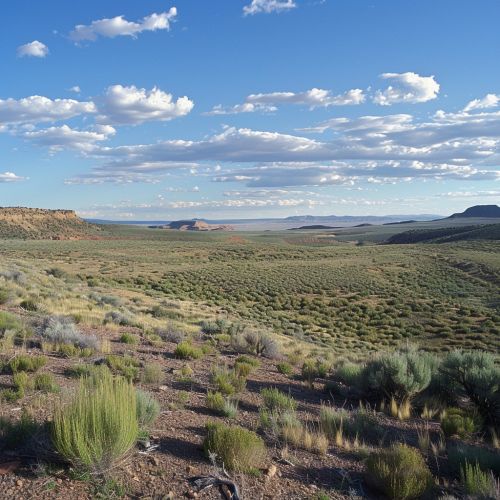San Juan Basin
Geography
The San Juan Basin is a geologic structural basin located primarily in northwestern New Mexico, extending slightly into southwestern Colorado in the United States. The basin covers an area of approximately 7,500 square miles and is bounded by the Chuska Mountains to the west, the San Juan Mountains to the north, the Jemez Mountains to the east, and the Zuni Mountains to the south.


Geology
The San Juan Basin is a significant part of the larger Colorado Plateau, which extends across the Four Corners region. The basin is an asymmetrical syncline, a type of fold that is typically a result of compressional tectonics. The San Juan Basin is unique in that it is filled with up to 15,000 feet of sedimentary rock, dating from the Late Cretaceous to the present. These rocks are rich in fossils and provide a detailed record of the paleoenvironment and paleoclimate of the region over the past 70 million years.
The basin is known for its rich deposits of coal, oil, and natural gas. The Fruitland Formation, a geologic formation within the basin, is one of the most productive coalbed methane reservoirs in North America. The basin also contains the largest known uranium deposits in the United States.
Climate
The climate of the San Juan Basin is classified as semi-arid, characterized by hot summers and cold winters. Precipitation is relatively low, with the majority falling during the summer monsoon season. The climate has played a significant role in shaping the landscape of the basin, influencing the erosion and deposition processes that have occurred over millions of years.
Flora and Fauna
The San Juan Basin is home to a diverse range of plant and animal species. The vegetation is primarily made up of desert shrubs, grasses, and juniper-pinyon woodland. The basin is also home to a variety of wildlife, including mule deer, pronghorn antelope, and a variety of bird species. The basin's biodiversity is largely influenced by its climate and geology, which provide a range of habitats for different species.
Human History
The San Juan Basin has a rich human history, with evidence of human habitation dating back thousands of years. The Ancestral Puebloans, also known as the Anasazi, inhabited the region from approximately AD 200 to 1300. The basin is home to numerous archaeological sites, including Chaco Culture National Historical Park, which was a major center of Ancestral Puebloan culture.
In the 19th century, the basin was the site of several conflicts between Native American tribes and European settlers. Today, the basin is home to several Native American tribes, including the Navajo Nation, the largest Native American reservation in the United States.
Economy
The economy of the San Juan Basin is heavily dependent on the extraction of natural resources. The basin is one of the largest producers of natural gas in the United States, and coal mining has also been a significant industry. In recent years, there has been a shift towards renewable energy sources, with several wind and solar farms being developed in the region.
